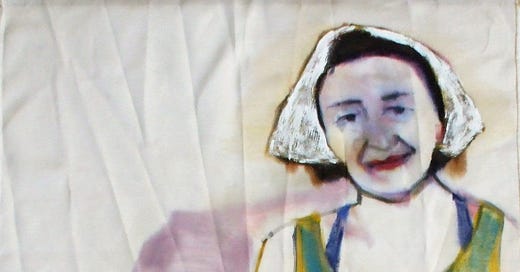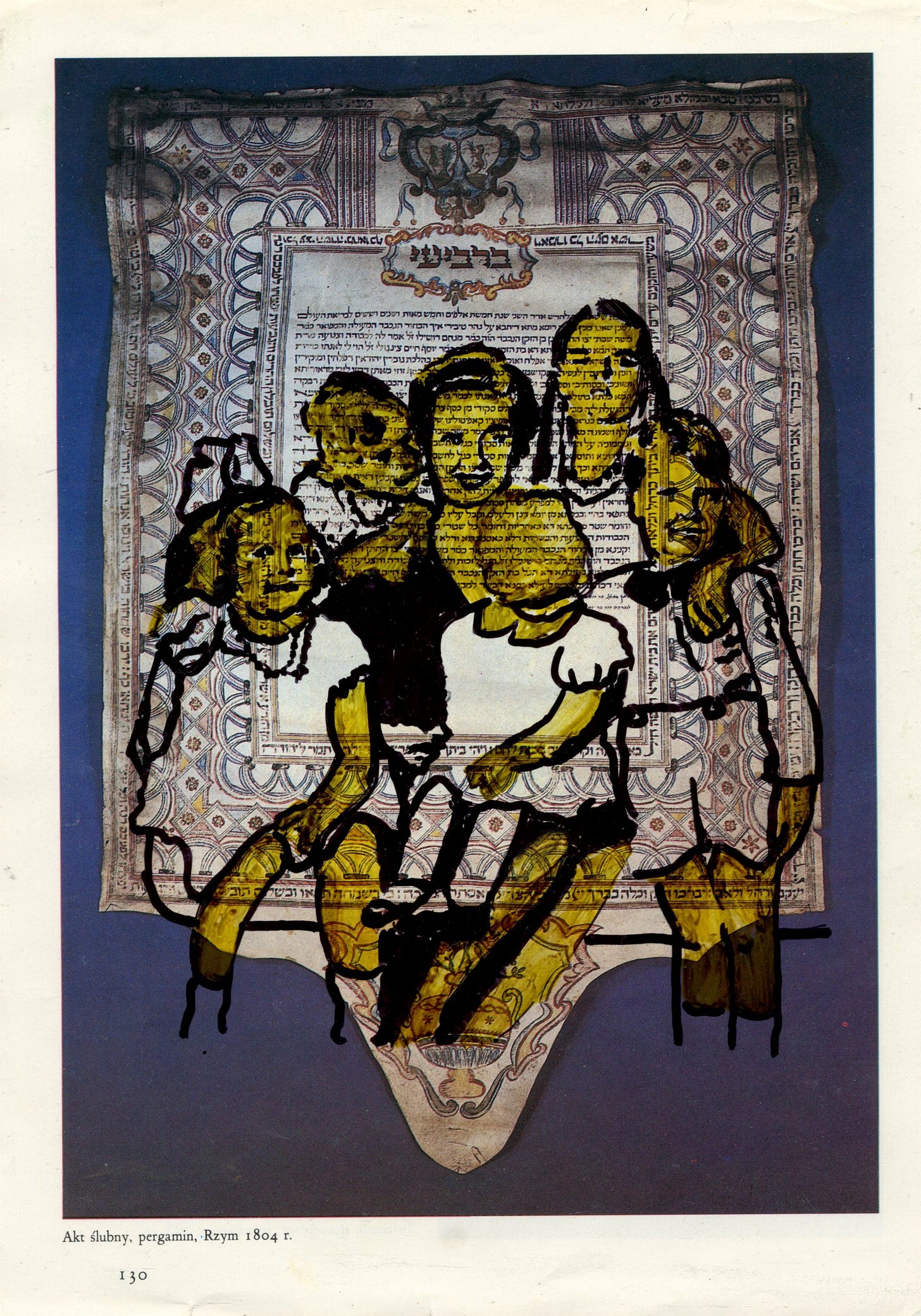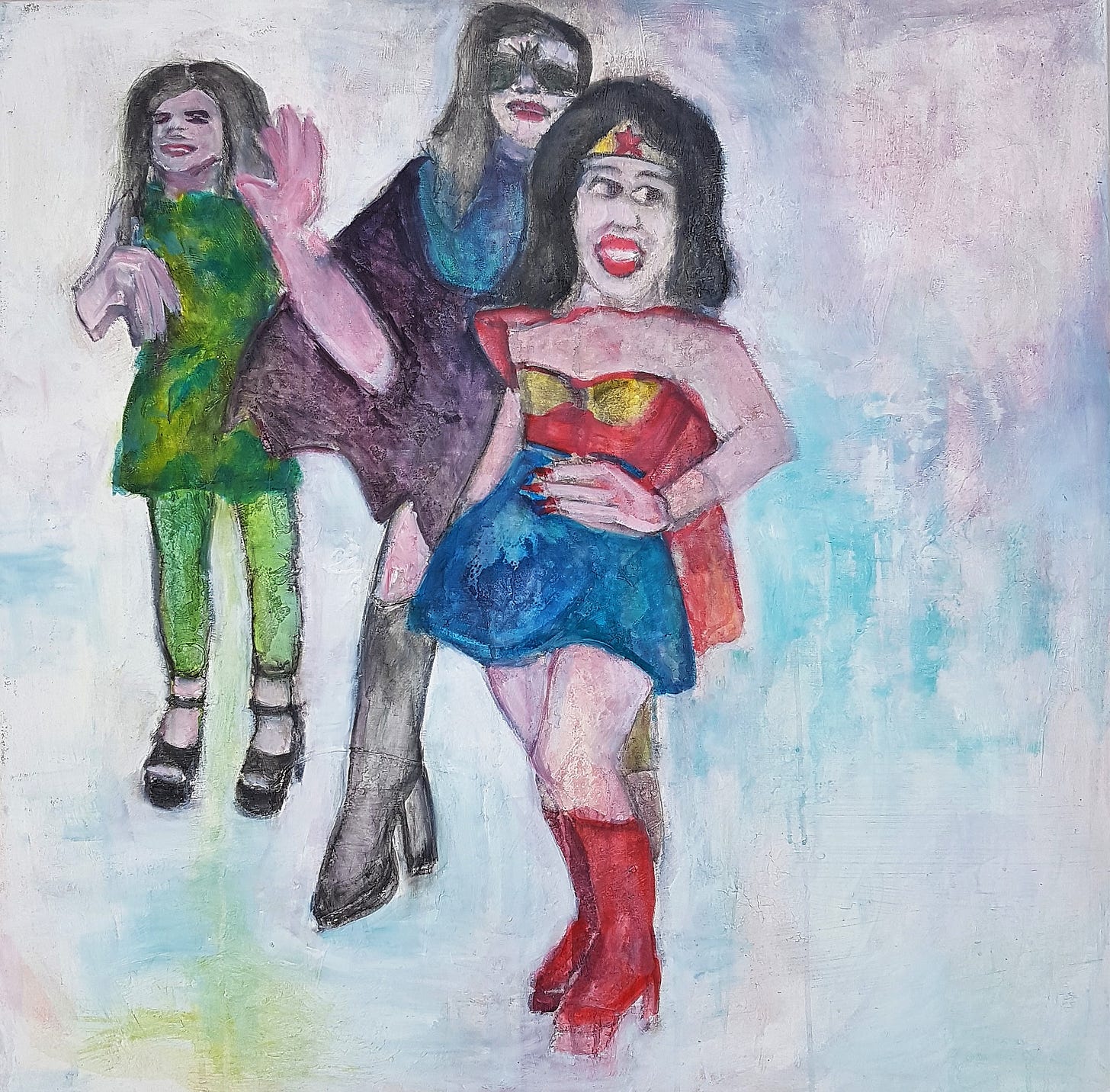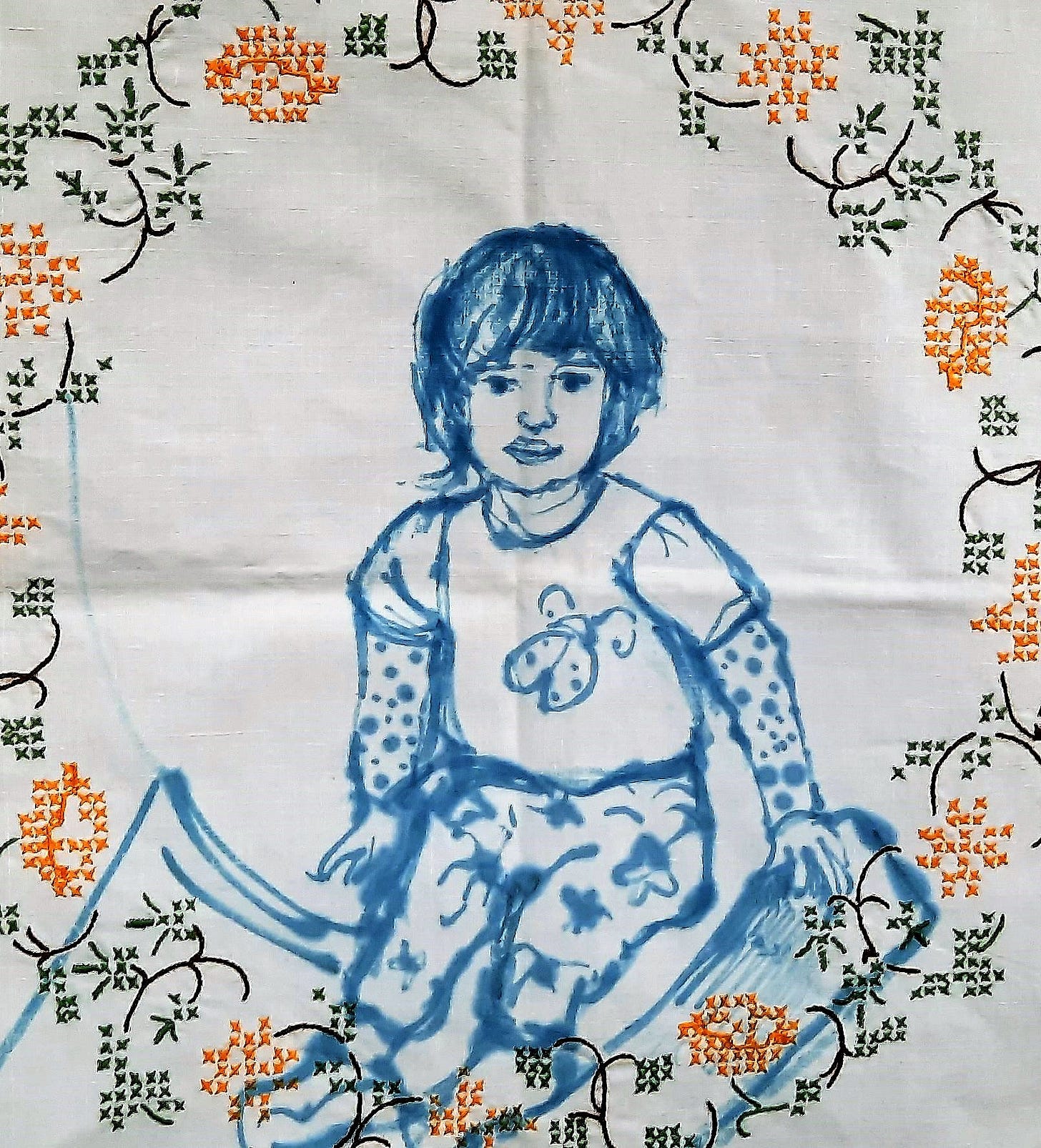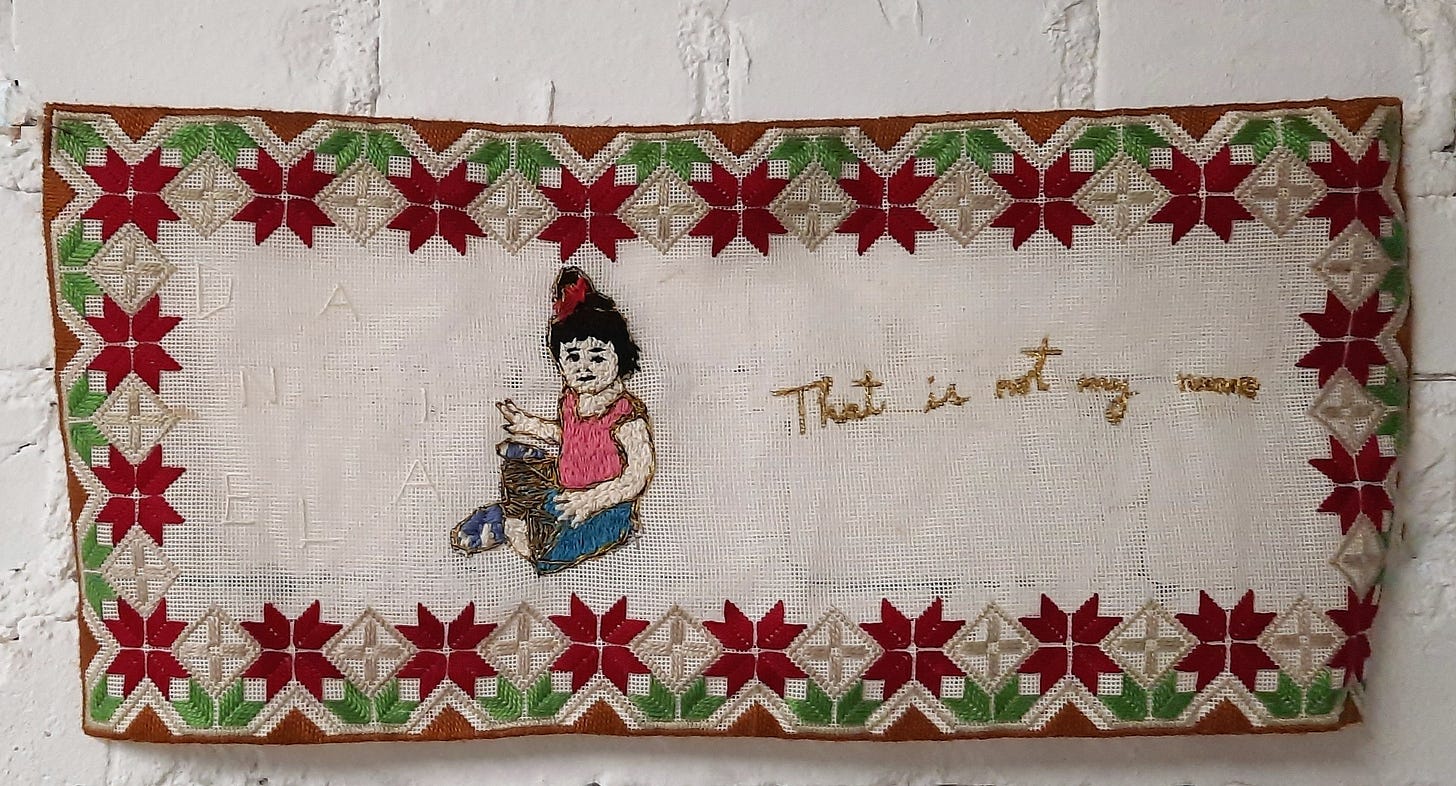Every Mother Needs A Child
Tarantula: Authors And Art's Inspiration For September, Paula Elion
Paula Elion is an artist. She is also white, a woman, she/her, Argentinean, Israeli, Jewish, straight, Stockholm-based, immigrant, she has three brothers, was a mother of two sons and a girl, and is now a mother of three sons. These are only a few of the duties, responsibilities, and labels that can be applied to Paula from the outside looking in. Has she become at ease with all of these identifications? Hardly. These terms that we use to describe a person, are mere containers waiting to be exposed, dissected and transformed into materials in her small studio that she turned into a lab for asking questions.
And what better way to begin living honestly and acceptingly than to delve into her own childhood? Paula Elion's work is deeply autobiographical, and she paints perfect pictures of her family using old family photos, letters, and books. But hidden under the smiles, smart clothing and united front are unattainable expectations. In today's world, what does it mean to be a girl? Is it true that every mother needs a daughter? How do these unrealistic responsibilities begin to ripple through the mother-daughter relationship?
To find out more about her work and to discover the disguised meaning behind some of the amazing titles that describe her series, I wandered down the long halls of the artist-run organization Detroit Stockholm, which is housed in the basement of a building in the heart of Stockholm. It was a quiet morning in the shared studio, and most of the spaces that I passed were filled with paints, different materials and works in progress calmly waiting for their creators to start the day. At the end of the corridor, though, I turned left into Elion’s cubicle, where she greeted me enthusiastically. Her studio space is small, hardly containing the creative chaos that can’t wait to be unleashed onto the canvases, and flower-shop wrapping papers as well as into sculptures combined with nativity dolls. Thank to her encouragement, I rolled up my sleeves and started pulling out different paintings that were just waiting to burst out of their crates and show their faces. I was met with bold colors, humor, and surprising topics—all of which we discussed in the conversation that follows.
Maja Milanovic: Tell us a little bit about yourself as a girl. Did you know early on that you wanted to become an artist?
Paula Elion: The answer is no, absolutely a grown-up thing. I loved drawing and sculpting as a girl, but I never imagined I would be a professional artist one day. I had been "programmed" by my mother to become an English teacher. Art wasn’t something very present in family conversations. I remember a library full of books that belonged to my older brothers – classics, but I don't think there were any art books in this collection.
I am the fourth child after three much older brothers. I was always surrounded by adults and I was an outspoken girl. When I was about nine, I became an "only child" because all my brothers had left home. I think this made me feel lonely at times. My imagination was often my companion.
I remember myself making little "pottery" out of dirt and water. My mother always loved plants so the materials came in valuable. I even painted flowers on the "pots.” I recall a few of short-lived drawing and ceramics seminars I attended, but it wasn't something I did on a regular basis.
For my 30th birthday, my husband Amir gave me two books – one was about women artists of the 20th century, and the other one was called "Stop Dreaming, Start Living." This combination blew my mind, and I decided to pursue this seriously. I enrolled in a 4-year artist diploma program – and loved it!
Now, I am a member of the Detroit Stockholm artist collective, and it feels so natural and fulfilling. Being part of a community of creators has always been a dream for me. And in Stockholm, it is coming to life.
What were your favorite toys when you were young? In some of your sculptures you still use what little girls like, naked baby dolls and flowers. Is there a connection and how important are different materials for your expression?
It is funny… I have just seen the movie "Barbie", which obviously raises many social and gender questions about these topics. The movie starts with an iconic scene in which a bunch of young girls start to violently smash their baby dolls after a gigantic "Barbie goddess" appears. The girls seem to abandon their mother role in favour of a doll that can provide companionship while also liberating them from the constraints of that duty. We could talk about this for hours …
As a girl, I had lots of dolls – not only baby dolls but also plastic girls that I could comb, dress and feed. I remember one in particular that my grandparents gave me for my birthday. This ginger plastic "girl" had amazing hair and a small plastic record on the back that I could play over and over. Unfortunately, I do not remember exactly what she used to tell me.
In my works, I use ready-mades to experiment and be surprised. For me not knowing the final result is the most exciting part of the process. The dolls came naturally years ago. Since I use objects and materials I find around me, these small baby dolls were at home. My kids used to bring them from kindergarten during the Passover holiday in Israel. This was a little Moses in the basket.
I found it interesting that this tiny plastic baby doll was mass produced in China and sold as Moses as well as little Jesus. Same doll, different worship purposes.
After some short research, I could find different types of baby dolls – basic one-piece dolls, babies with movable heads and limbs, as well as painted eyes and mouths. So exciting!
I also use small girl dolls and textiles, which I combine with real flowers I dip in paint and varnish. I think that in the process, I want to preserve these flowers while allowing transformation.
In general, different materials are extremely important for my work. Often, they dictate the form and possibilities I can express. My studio is like a laboratory. For me, the experimentation process is just as important as the outcome.
All of the preceding questions led to your series Every Mother Needs A Girl, which I discovered on your website and was the initial reason I wanted to contact you to discuss your art. The title is intriguing and sparks many discussions. Can you tell us about the source of your inspiration for this, your first solo show, as I subsequently discovered? Also, how do the roles of daughter and artist interact with one another?
"Every mother needs a girl" was my first solo exhibition in Jaffa -Tel Aviv in 2012. The original version of this statement was "Every mother needs a daughter". This is something a woman told me while I was waiting for my regular pregnancy checkup. This was my third child and she had asked me what was the sex of the baby. When I said it was a girl, she told me that sentence, and added that it was great, because she only had boys, whom she loved dearly, of course.
The whole concept of "needing" a girl sounded ridiculous to me. Maybe because I had heard all my life my mother telling me how happy she was after having me at 40, after three boys – teenagers at the time. She had been "looking for the girl" all her life. I still think this is a problematic and sad idea for obvious reasons.
We, girls, are all daughters, right? We need to fulfill this role in one way or another. We are usually inculcated from a young age that being nurturing, kind and loving are – or should be – our natural traits. I think that today there is more awareness but still, for many people, women are supposed to be not only perfect mothers but also caring daughters.
Being both a mother and an artist wasn't always easy. I had very stressful periods when I was studying, working as a Spanish teacher, taking care of the kids. I stayed up late just to do my art homework.
Every Mother Needs A Girl is told from the daughter's point of view. This is followed by subjects of a similar nature. Fucking Childhood, Secrets And Lies, but you're an artist and a mother of three these days. What did you learn as a mother from the prior shows? And are you attempting to remedy what the prior generation misunderstood?
I do not think my goal should be trying to correct or educate people. What I want with my art is to raise questions, to start a conversation, to encourage people to reflect on issues that make me anxious, worried, annoyed but also happy. I do want to bring to light issues that might have been swept under the carpet in previous generations. Probably in all my projects, the personal and the universal intertwine. It may start from old family photos, or letters I received from my parents, or it may be by observing social media, pop culture, or advertising interpreting them from my perspective.
In the past few years, I participated in two residencies in Berlin – each for about 3 months. It could be said that I "neglected" my role as a mother, and left my children behind. But for me it wasn't so. It was in fact role modeling for them that one should pursue their passions, in spite of the potential cost and, sometimes, against social norms. No one would ask a man "how is your wife going to cope alone with the kids?" if he went away for some months, but they did ask me if my husband will manage. And he did so wonderfully.
You are Argentinean-Israeli and Jewishboth culturally and religiously, yet when you went to Berlin for a residence, you didn’t explore your own heritage as many would have expected. You put on your ‘mother hat’ and tried to understand how Magda Goebbels, the wife of the notorious Nazi propagandist Joseph Goebbels, felt as she was killing her children before she and her husband committed suicide when the war was lost. What made you take that angle?
I love this question.
For me it was more a fascination with Magda's personal story. I read her biography, and was surprised that her step father, whom she loved dearly, was Jewish. Her first boyfriend was Haim Arlozorov – one of the leading Zionist and a forefather of the Israeli state. She used to attend the Zionist meetings in Berlin. Then, with a strange twist of fate, she became the "First lady" of the Third Reich. A role model of a perfect mother of six kids. They were the "perfect Arian family." Even though Goebbels was a womanizer, and she wanted to leave him, but Hitler forbade it.
So for me, it is about the tragic story of a woman, a mother, a betrayed wife, who at the same time loved to play the role of first lady, with a tragic ending. I chose to focus on one specific story, through which I could reflect on the human condition, morals, and gender roles. Was she a victim? Was she a victimizer? How could she murder her kids when she was offered to take them from the bunker to a safe place? What was going through her mind?
I was watching the historical propaganda videos of the kids dancing and singing, and when I was painting their "perfect" images I couldn't stop crying. So, I asked myself if it was OK to cry for a tragic Nazi story. But pain is pain is pain is pain.
Is art a tool to understand and better yourself or the world as whole? Is it your way to ask questions?
For sure. Being an artist, has allowed me to express my ideas and feelings without words, in a universal language. I think it is amazing I can create an image that can carry many different meanings. In my opinion, the ideal work is the one that asks questions. The viewer can come up with the answers using their own experience as reference. However, not finding all the answers is even better. Making art has helped me connect with people in ways I could have never imagined. I have met so many interesting people along the way! Sharing experiences helps us realize we have more in common than we think.
I would like for you to talk a little bit about your technique. What’s quite prominent is how you use the white of the canvas as a color and a lot of primary colors. And how different is your style now from when you started at art school?
I went to Art School in Israel – The Midrasha, Beit Berl. There I could learn different techniques but my first love was painting. I had a great mentor, a painter called Asad Azi. From him I learned how to use color and form and I consider him a great influence on my work. After using more traditional techniques, canvas, oil, acrylic I felt the need to literally abandon the square.
Back in 2011, I had my first studio: a container, literally a metal box in someone's garden. One day, the owner brought me as a present several meters of cloth. Since this cloth absorbs but also rejects the paint, surprises are easy to "create".
This was the beginning of a journey experimenting, trying materials whose original purpose was not an artistic one. Today, I regularly use real flowers, textiles, second hand sheets and tablecloths. I have also recently created some installations with tin foil paper and baking paper from my kitchen. I believe that materials add another layer of meaning to the piece.
Before your new show that we will talk about in a minute, besides finding inspiration in your family, you have also been drawn to the LGBTQ community. Can you talk a little bit about that.
Yes, and this connects with my previous subject mother-daughter relationship. It is interesting to see how all the puzzle parts come together to make sense as a whole.
I was drawn to queer subjects for the simple reason that I couldn’t believe that today it might be still seen as controversial and people get judged for who they are or who they love. In my series "Fun fair" my inspiration was media photos of pride parades and costume catalogs. Even before that, through paintings based on scenes from the movie "Brokeback Mountain," I dealt with the topic of imposed roles and expectations on two cowboys who love each other but cannot fulfill their love.
In 2016, I participated in a group exhibition called "Iran, Iran" in Israel. For this exhibition, I created an installation made of wooden frames, old books and cardboard. The images were based on a documentary I had seen called "Trans in Iran." This series of interviews shows that in a country where being gay is punishable by death, trans is actually a legitimate way to "escape" the predefined gender roles.
All this prepared me in an uncanny way for my recent reality of becoming a mother to a trans boy. At the moment, I am revisiting my role of a mother and joining my son in his journey of self-discovery. I am learning to use new pronouns, a new name – sometime it is a bit hard and emotional.
Tell us about your new show that will open next month at Detroit Stockholm.
It's going to be a duo with Maja Stjärna, which will include embroidery, objects with flowers, and possibly babies – we'll see. It's called Stitching Stories.
I dissect childhood photographs of my son (whom I considered to be a girl at the time), observe them, draw the images on readymade textiles that have some embroidery on them. Alternatively, I add the embroidery on cloth along the lines of those images.
Maja and I come from different generations and different parts of the world, but are connected through our interest in home textiles, and their relationship to family and heritage. In our conversations we have found that we both are interested in working with subjects connected to the roles we play as humans in society, especially roles assigned to women, and the expectations and pressures to fulfill these roles.
The materials themselves are also connected to the idea of outside expectation and pressure, as women before us have been expected to make all these home textiles. The used textiles show traces of use, damage, holes, stains, as our faces and bodies show the traces of our lives and age. Wrinkles on fabrics, wrinkles on faces. Every stain counts and carries past memories. The past and the present collide when a new image appears on the surface.
My work in this exhibition also transforms and makes objects travel through time, and take upon themselves new representations and meanings. I use flowers, for example, because I can shape them into new forms. Preserving them, "freezing" them in time, is part of the game. I play with them and create my own composition. My gaze. These flowers become something else, they experience transformation. Like us, flowers are labeled, put into categories.
What does your son think about your new show?
He is pretty cool about it. He gave me his permission to deal with this subject and to make him center stage. He even encouraged me to use those old photos, that do not represent him anymore. He also loves visual arts, draws, paints, and creates jewelry.
Through transitioning through your life as a girl, daughter, mother, artist, Argentinean, Israeli … maybe one could actually conclude that Every Mother Just Needs A Child.
Exactly! Especially now that my son is transitioning, this takes on a new meaning. I can see my previous projects in a new light. I couldn't agree more that my initial intuition and discomfort with the "Every mother needs a daughter/girl" version was correct.
Where could our readers find more about you?
On my website they can see previous and current work, as well as some media coverage – www.paulaelion.com
I also share some images, news on projects and exhibitions on my Instagram (https://www.instagram.com/paula_elion/) and Facebook page. I am more than happy to host visitors in my studio at Detroit Stockholm Artist Collective. Just reach out and we can schedule a meeting.
Thank you Paula and good luck on your new journey! If in Stockholm, you can check Paula’s new show on October 5th at Detroit Stockholm. Save the Date!
Last month was dedicated to the work of Joakim Allgulander. To read articles inspired by his work, click on the following link/s:
A Pixelated World by Maja Milanovic
Nature as Nurture by Lidia Oshlyansky
To read about other artists that we featured, please visit our Archives.
The following bonus material from Paula’s studio is for our paid subscribers. Thank you for your support.
Keep reading with a 7-day free trial
Subscribe to Tarantula: Authors and Art to keep reading this post and get 7 days of free access to the full post archives.

